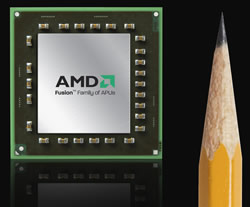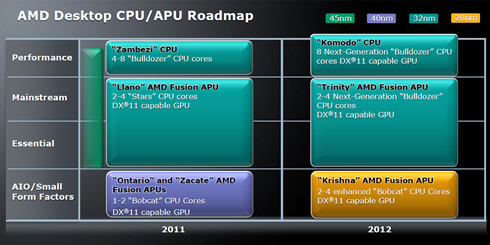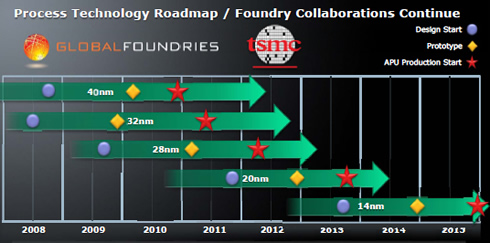
AMD Unveils Future of Computing at Annual Financial Analyst Day
At its annual Financial Analyst Day, AMD gave the first public demo of
its "Bulldozer" CPU, an update on the schedule for our first AMD Fusion Accelerated Processing Units (APUs) and the latest additions to the company's public roadmaps.
AMD executives detailed how this new class of processor, AMD Fusion
Accelerated Processing Units (APUs), is poised to create a sustained
position of advantage by powering demanding PC workloads in sleek form
factors with long battery life. AMD Fusion APUs are built from DirectX
11-capable GPU technology and either low-power or high-performance
multi-core x86 CPU technology. These APUs are designed to improve today's
Internet, video processing and playback, and gaming (client and online)
experiences. For the first time, AMD also demonstrated its new
high-performance x86 multi-core CPU architecture codenamed "Bulldozer" and
provided additional information around the "Bulldozer" launch schedule.
 "AMD's
business model has consistently delivered operating profits this year,
while the strength of our platform offerings drove continued expansion of
our customer base," said Dirk Meyer, AMD president and CEO. "The industry
is at an inflection point, with users demanding technology that is more
immersive and interactive. With our upcoming AMD Fusion APUs combining our
DirectX 11-capable graphics processors and next-generation microprocessors
on a single chip, we are poised to lead the industry's next computing era
with richer, more vivid digital experiences."
"AMD's
business model has consistently delivered operating profits this year,
while the strength of our platform offerings drove continued expansion of
our customer base," said Dirk Meyer, AMD president and CEO. "The industry
is at an inflection point, with users demanding technology that is more
immersive and interactive. With our upcoming AMD Fusion APUs combining our
DirectX 11-capable graphics processors and next-generation microprocessors
on a single chip, we are poised to lead the industry's next computing era
with richer, more vivid digital experiences."
"AMD Fusion products represent the biggest advancement in processor technology since the industry's switch to multi-core designs," observed Nathan Brookwood, research fellow at Insight 64. "AMD Fusion enables a quantum increase in the performance of entry-level and mainstream processors, and helps software developers enrich their offerings in ways that would previously have been hard to imagine. These enhanced applications, in turn, will give the PC industry tools to tap into new opportunities that only the latest GPU technology can provide."
AMD Fusion APUs are expected to address evolving workloads and users' needs for smaller, more power-efficient form factors that enable richer visual computing experiences such as responsive web browsing, high quality web graphics, smooth video playback of HD and 3D content, GPU-accelerated applications such as Microsoft PowerPoint where AMD Fusion enables smooth transitions, better animations, easier video editing. APUs will also offer user interface innovations designed to evolve as new technologies such as gesture recognition and voice command take advantage of the parallel processing capability of GPUs, as evidenced by the hundreds of gigaflops of compute power in the AMD Fusion APU codenamed "Llano".
By the end of 2012, every new server CPU AMD bring to market will be based on its new "Bulldozer" architecture. "Bulldozer" will power multiple platforms designed to give server buyers more threads, more memory and the high performance-per-watt, per-dollar. AMD announced several notable updates to its 2012 roadmaps including:

* "Krishna" and "Wichita": Two and four-core 28nm APUs based on the next-generation sub-one watt "Bobcat" CPU cores and a DirectX 11-capable GPU, designed for the tablet, notebook, HD netbook, and desktop form-factors; "Krishna"APUs are scheduled to be available for small form-factor and all-in-One (AIO) desktop platforms in 2012;
* "Trinity": a 32nm APU based on AMD's next-generation "Bulldozer" CPU cores and a DirectX 11-capable GPU, designed for mainstream and high-performance desktops and notebooks;

* "Komodo": a 32nm CPU featuring up to 10 AMD "Bulldozer" CPU cores designed for high-performance and enthusiast desktops; available in 2012.

* "Terramar" and "Sepang": Two new 32nm CPUs for the server market based on AMD's "Bulldozer" CPU core planned for release in 2012. Targeted for the enterprise, mainstream market "Terramar" will scale up to 20 cores while "Sepang" is designed for the cost-optimized, energy efficient market (low-power 1- and 2-way platforms) and will scale up to 10 CPU cores.
If you track AMD's roadmap closely each year you may notice something different this time - no more platform code names are listed. That's because AMD has simplified its roadmaps to make it more clear which markets and form factors our CPUs and APUs will address.
AMD also provided details on its manufacturing process roadmap. The company will continue to receive chips from Globalfoundries and TSMC. According to the roadmap, the first 28nm prototypes will be delivered after the mid of 2011, followed by the first 32nm APu chips. In 2011, the companies will initiate the first 20nm chip designs, which are expected to reach the prototype stage in mid 2012. The first 20nm APus are expected to be produced in Q1 of 2013. Looking forward, the first 14nm prototypes will be introduced in the middle of 2014 and their production schedulled to start in the end of 2015.

Graphics roadmap
AMD also confirmed its desktop discrete graphics products for Q1 2011. These new graphics cards will be based on the upcoming "Antilles" and "Cayman" GPUs, and will include the Radeon HD 6990, HD 6970, HD6950 graphics cards. AMD also released in Q1 2010 the "Turks" and "Caicos" GPUs.

In the mobility sector, AMD talked about the "Vancouver" graphics platform, which will include the "Blackcomb" (40nm, DX11) GPU for the high-end and entusiast segment, the "Granville" GPU for high-performance mobile devices, the "Whistler" GPU (DX11, Stereo/BD3D, Dynamic SG), the "Capolano" (128-bit DX11), the "Seymour" and the "Robson" GPUs:

 "AMD's
business model has consistently delivered operating profits this year,
while the strength of our platform offerings drove continued expansion of
our customer base," said Dirk Meyer, AMD president and CEO. "The industry
is at an inflection point, with users demanding technology that is more
immersive and interactive. With our upcoming AMD Fusion APUs combining our
DirectX 11-capable graphics processors and next-generation microprocessors
on a single chip, we are poised to lead the industry's next computing era
with richer, more vivid digital experiences."
"AMD's
business model has consistently delivered operating profits this year,
while the strength of our platform offerings drove continued expansion of
our customer base," said Dirk Meyer, AMD president and CEO. "The industry
is at an inflection point, with users demanding technology that is more
immersive and interactive. With our upcoming AMD Fusion APUs combining our
DirectX 11-capable graphics processors and next-generation microprocessors
on a single chip, we are poised to lead the industry's next computing era
with richer, more vivid digital experiences."
"AMD Fusion products represent the biggest advancement in processor technology since the industry's switch to multi-core designs," observed Nathan Brookwood, research fellow at Insight 64. "AMD Fusion enables a quantum increase in the performance of entry-level and mainstream processors, and helps software developers enrich their offerings in ways that would previously have been hard to imagine. These enhanced applications, in turn, will give the PC industry tools to tap into new opportunities that only the latest GPU technology can provide."
AMD Fusion APUs are expected to address evolving workloads and users' needs for smaller, more power-efficient form factors that enable richer visual computing experiences such as responsive web browsing, high quality web graphics, smooth video playback of HD and 3D content, GPU-accelerated applications such as Microsoft PowerPoint where AMD Fusion enables smooth transitions, better animations, easier video editing. APUs will also offer user interface innovations designed to evolve as new technologies such as gesture recognition and voice command take advantage of the parallel processing capability of GPUs, as evidenced by the hundreds of gigaflops of compute power in the AMD Fusion APU codenamed "Llano".
By the end of 2012, every new server CPU AMD bring to market will be based on its new "Bulldozer" architecture. "Bulldozer" will power multiple platforms designed to give server buyers more threads, more memory and the high performance-per-watt, per-dollar. AMD announced several notable updates to its 2012 roadmaps including:

* "Krishna" and "Wichita": Two and four-core 28nm APUs based on the next-generation sub-one watt "Bobcat" CPU cores and a DirectX 11-capable GPU, designed for the tablet, notebook, HD netbook, and desktop form-factors; "Krishna"APUs are scheduled to be available for small form-factor and all-in-One (AIO) desktop platforms in 2012;
* "Trinity": a 32nm APU based on AMD's next-generation "Bulldozer" CPU cores and a DirectX 11-capable GPU, designed for mainstream and high-performance desktops and notebooks;

* "Komodo": a 32nm CPU featuring up to 10 AMD "Bulldozer" CPU cores designed for high-performance and enthusiast desktops; available in 2012.

* "Terramar" and "Sepang": Two new 32nm CPUs for the server market based on AMD's "Bulldozer" CPU core planned for release in 2012. Targeted for the enterprise, mainstream market "Terramar" will scale up to 20 cores while "Sepang" is designed for the cost-optimized, energy efficient market (low-power 1- and 2-way platforms) and will scale up to 10 CPU cores.
If you track AMD's roadmap closely each year you may notice something different this time - no more platform code names are listed. That's because AMD has simplified its roadmaps to make it more clear which markets and form factors our CPUs and APUs will address.
AMD also provided details on its manufacturing process roadmap. The company will continue to receive chips from Globalfoundries and TSMC. According to the roadmap, the first 28nm prototypes will be delivered after the mid of 2011, followed by the first 32nm APu chips. In 2011, the companies will initiate the first 20nm chip designs, which are expected to reach the prototype stage in mid 2012. The first 20nm APus are expected to be produced in Q1 of 2013. Looking forward, the first 14nm prototypes will be introduced in the middle of 2014 and their production schedulled to start in the end of 2015.

Graphics roadmap
AMD also confirmed its desktop discrete graphics products for Q1 2011. These new graphics cards will be based on the upcoming "Antilles" and "Cayman" GPUs, and will include the Radeon HD 6990, HD 6970, HD6950 graphics cards. AMD also released in Q1 2010 the "Turks" and "Caicos" GPUs.

In the mobility sector, AMD talked about the "Vancouver" graphics platform, which will include the "Blackcomb" (40nm, DX11) GPU for the high-end and entusiast segment, the "Granville" GPU for high-performance mobile devices, the "Whistler" GPU (DX11, Stereo/BD3D, Dynamic SG), the "Capolano" (128-bit DX11), the "Seymour" and the "Robson" GPUs:






















